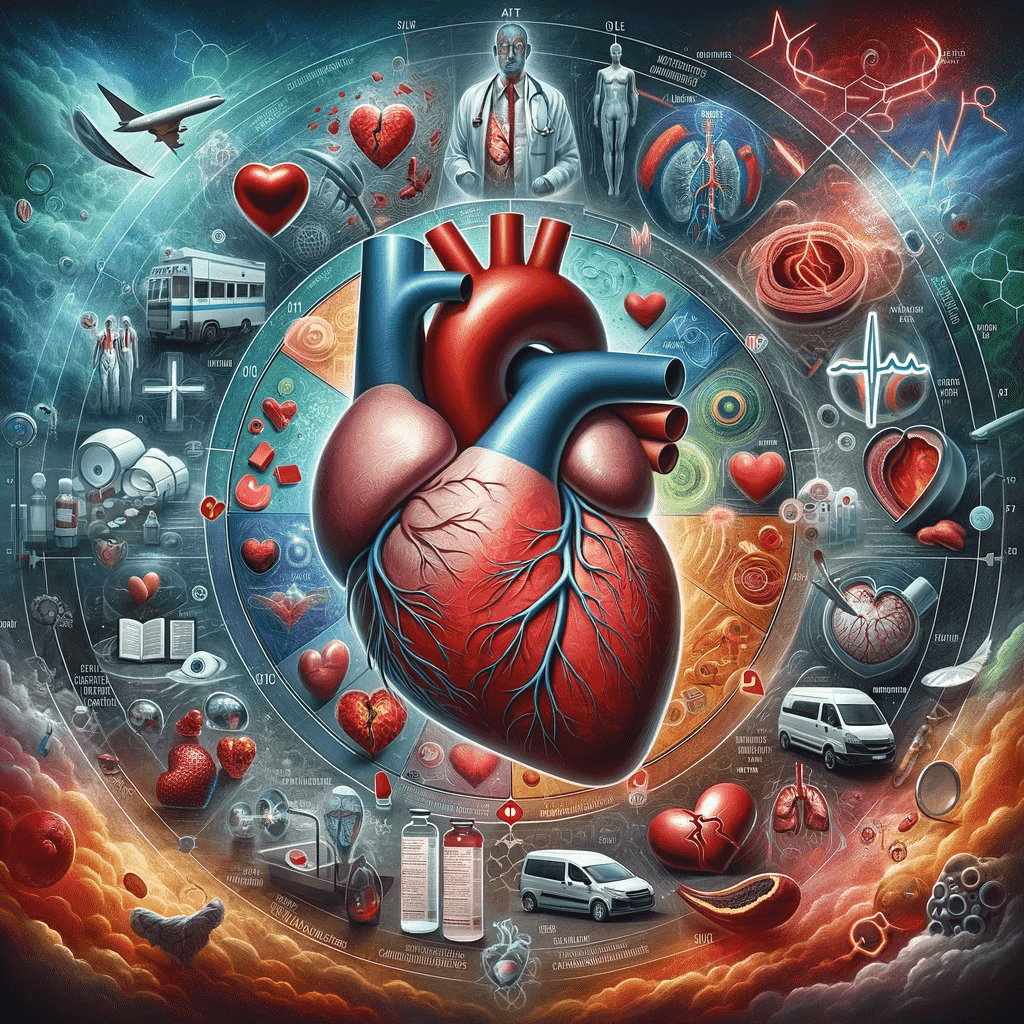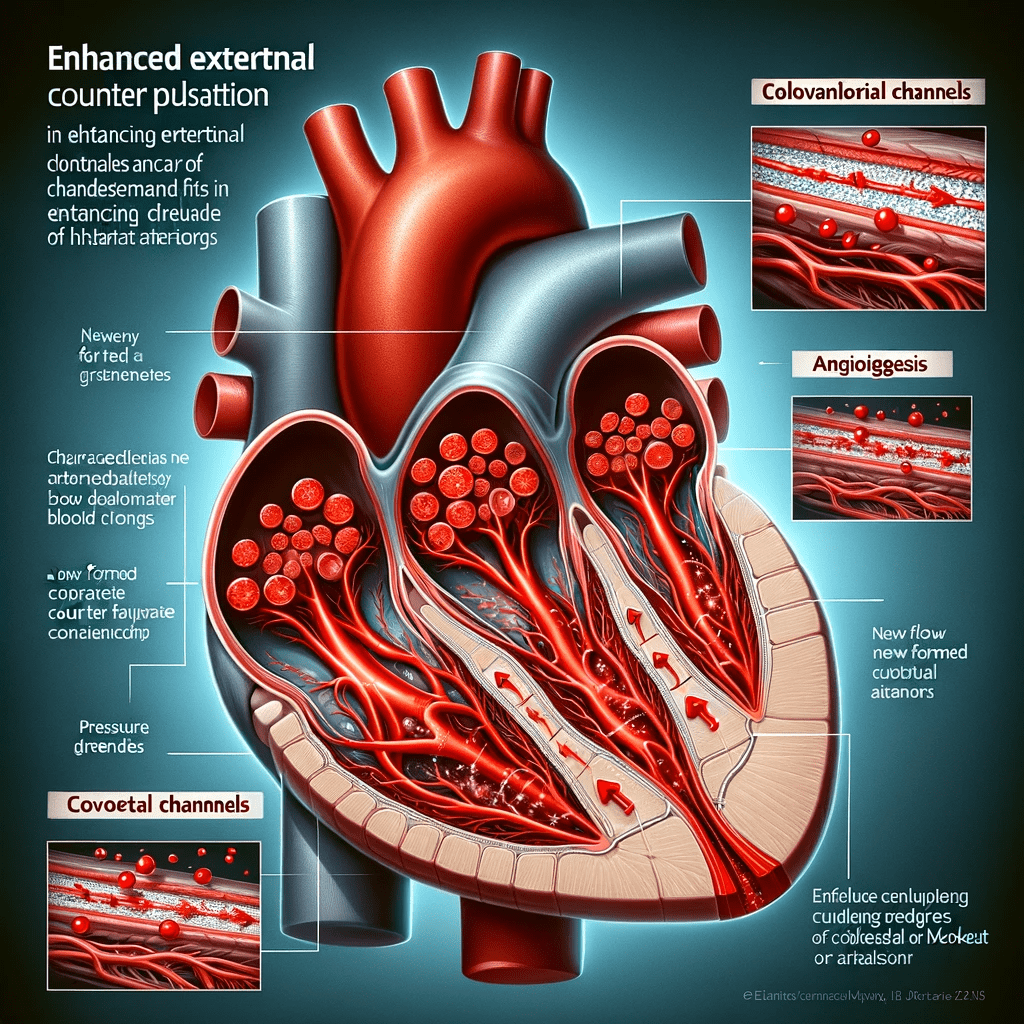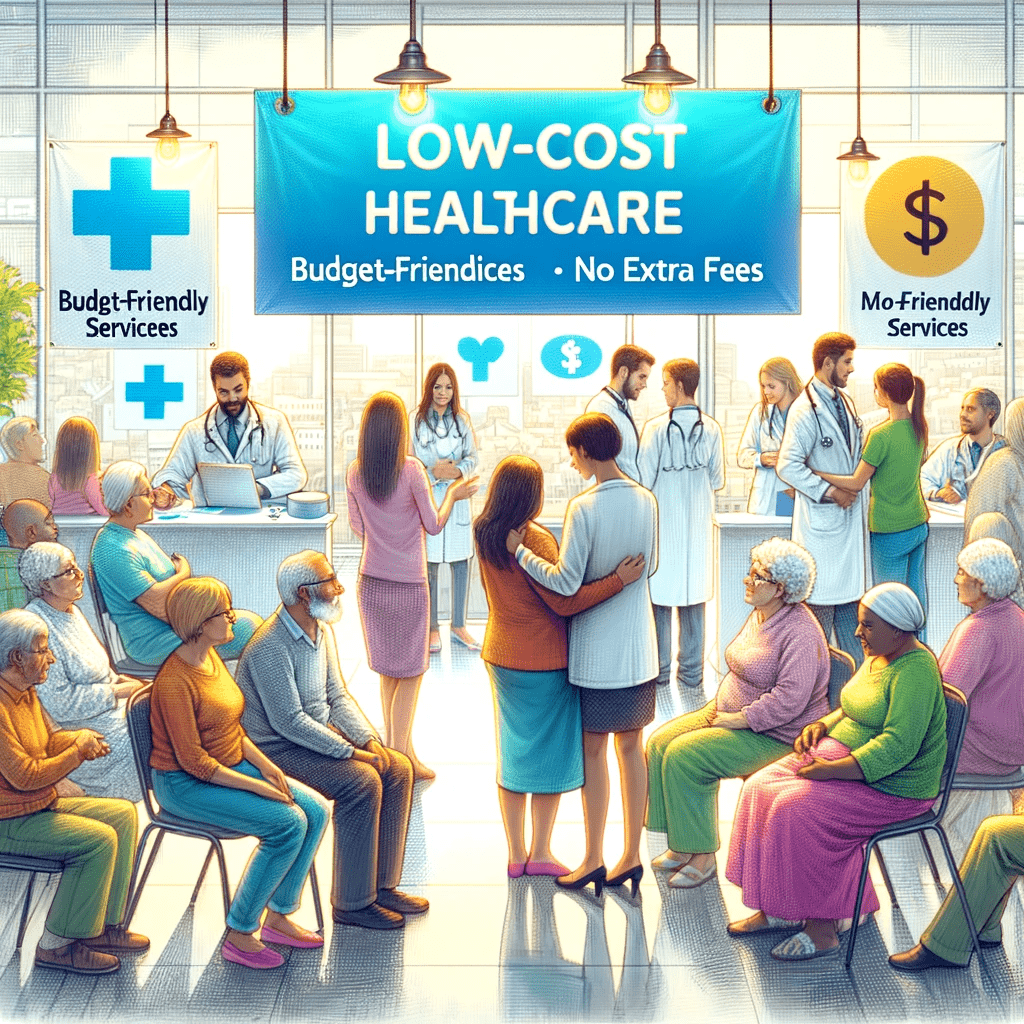Excerpt
Heart disease, including Coronary Artery Disease (CAD), heart attacks, heart failure, and angina, is a major global health issue. Among various treatments, approved by the USFDA (US Federal Drugs Administration), Enhanced External Counter Pulsation (EECP) has emerged as a notable therapy in cardiac care globally and in India. This article delves into the pros and cons of EECP for treating angina and its effects on coronary artery disease, heart attack prevention, and heart failure management. EECP, a non-invasive therapy, shows promise in improving cardiac conditions and quality of life for patients with heart diseases.
Introduction
Heart disease, encompassing conditions such as Coronary Artery Disease (CAD), heart attacks, heart failure, and angina, remains a significant global health concern. While medical advancements have led to various treatments and interventions, one innovative therapy stands out in the field of cardiac care: Enhanced External Counter Pulsation (EECP). This article explores the advantages and disadvantages of EECP treatment for angina and its impact on coronary artery disease, heart attack prevention, and heart failure.

Advantages and Disadvantages of EECP Treatment for Angina
Angina, characterized by chest pain or discomfort due to reduced blood flow to the heart muscle, is a common symptom of CAD. EECP treatment offers several advantages and disadvantages in managing angina.
Advantages:
- Non-invasive: EECP is a non-surgical, non-pharmacological treatment option, reducing the risks associated with invasive procedures and medications.
- Enhanced blood flow: EECP enhances blood flow to the heart, alleviating angina symptoms and reducing the need for medications.
- No side effects: Unlike medications, EECP has no adverse side effects, making it a safe choice for those who cannot tolerate pharmaceuticals.
- Long-lasting benefits: The benefits of EECP therapy can persist for several years, providing sustained relief from angina.
- Disadvantages:
- Time-consuming: EECP therapy requires multiple sessions, typically lasting 1-2 hours each, over several weeks, which may not be convenient for everyone.
- Limited availability: Access to EECP therapy can be limited in some regions, potentially restricting its availability to certain patients.
- Not suitable for all: EECP may not be suitable for individuals with certain medical conditions or those at advanced stages of heart disease.Revolutionizing Heart Health:
EECP Treatment at Masters Cardio Diabetic Care, Chennai, India
One center at the forefront of offering EECP treatment is the Masters Cardio Diabetic Care Heart Center, dedicated to revolutionizing heart health through innovative therapies. Masters Cardio Diabetic Care Heart Center integrates EECP into its treatment programs, providing hope and healing to countless individuals with heart conditions.
How Does EECP Therapy Work?
EECP therapy operates on the principle of External Counter Pulsation, a non-invasive technique that enhances blood flow to the coronary arteries. It involves the use of inflatable cuffs wrapped around the patient’s legs, buttocks, and lower abdomen. These cuffs are synchronized with the patient’s heartbeat, inflating and deflating in rhythm to create a pulsation effect.
During diastole (the resting phase of the heart’s pumping cycle), the cuffs inflate, increasing blood flow to the coronary arteries. This action improves oxygen supply to the heart muscle and reduces the workload on the heart during systole (the contraction phase).

How Long Does EECP Therapy Take?
The duration of EECP therapy varies from patient to patient. A typical course of treatment involves 35 one-hour sessions spread over seven weeks, with five or six sessions per week. However, some individuals may require more or fewer sessions based on their specific needs and response to treatment.
What is EECP Treatment?
Enhanced External Counter Pulsation (EECP) is a non-invasive, outpatient treatment that improves blood flow to the heart. This therapy has shown remarkable efficacy in managing various heart conditions, particularly angina, by enhancing oxygen delivery to the heart muscle.
Understanding Angina: Your Heart’s Message
Angina serves as a warning sign from your heart, signaling an inadequate supply of oxygen-rich blood to the heart muscle. This condition, characterized by chest pain or discomfort, typically arises when the coronary arteries responsible for supplying blood to the heart become narrowed. The primary cause of this narrowing is the buildup of plaque, a mixture of fat, cholesterol, and other substances, which can significantly reduce blood flow to the heart muscle.
In the context of treating angina, Enhanced External Counter Pulsation (EECP) therapy has emerged as an innovative approach. EECP works on the principle of enhancing blood flow to the heart, thereby addressing the root cause of angina – insufficient blood supply. During EECP therapy, a series of cuffs wrapped around the patient’s legs and buttocks rhythmically inflate and deflate in sync with the heartbeat. This process creates a counter pulse or a wave of pressure that helps in boosting blood flow back to the heart. As a result, the heart receives an increased supply of oxygen-rich blood, which is critical in alleviating the symptoms associated with angina.
Furthermore, EECP therapy contributes significantly to cardiovascular health by facilitating the formation of new natural bypass channels, commonly known as collaterals, within the heart. This remarkable process is central to the therapy’s effectiveness and offers several long-term advantages for patients with heart conditions.
- Formation of Collateral Channels: One of the key mechanisms by which EECP enhances heart function is through the development of these collateral channels. These are essentially new blood vessels that form as a natural response to the increased blood flow and pressure gradients created by EECP. This process, known as angiogenesis, is the body’s way of circumventing blocked or narrowed arteries, which are often the underlying cause of reduced blood flow to the heart.

- Improvement in Blood Flow: The newly formed collateral channels play a crucial role in improving blood flow to parts of the heart that were previously under-supplied due to arterial blockages. By providing alternative pathways for blood to reach heart tissue, these collaterals ensure a more efficient and effective circulation within the heart. This improved blood flow is vital in delivering oxygen and nutrients to the heart muscle, enhancing its function and resilience.
- Reduction in Angina Symptoms: The enhanced blood flow resulting from collateral circulation has a direct impact on reducing angina symptoms. Patients often experience less frequent and less intense chest pain and discomfort, a primary symptom of inadequate blood supply to the heart. This reduction in symptoms can significantly improve patients’ ability to engage in physical activities without discomfort, thereby enhancing their daily life quality.
- Long-term Benefits: The benefits of collateral circulation formed through EECP are not just immediate but also long-term. These newly developed channels remain functional even after the completion of the EECP treatment course, providing ongoing benefits in blood supply to the heart. This sustained improvement in cardiac circulation can help in slowing the progression of heart disease and reducing the likelihood of future cardiac events.
- Enhancement of Overall Quality of Life: The cumulative effect of these improvements — better blood flow, reduced angina symptoms, and a healthier heart — contributes to a significant enhancement in the overall quality of life for patients. With fewer symptoms and increased physical capability, individuals can enjoy a more active and fulfilling life.

Therefore, the formation of collateral channels through EECP therapy represents a vital aspect of its effectiveness in treating heart conditions. By naturally creating alternative pathways for blood flow within the heart, EECP offers a non-invasive solution to improve heart health, reduce symptoms, and enhance the overall quality of life for patients with cardiovascular diseases
EECP therapy is typically administered in sessions over several weeks, and patients often report significant improvements in symptoms such as chest pain, shortness of breath, and fatigue. This non-invasive therapy is particularly beneficial for patients who are not candidates for surgical procedures like angioplasty or bypass surgery.
Therefore, EECP therapy represents a significant advancement in the non-invasive treatment of angina. By increasing blood flow to the heart and encouraging the development of new blood vessels, EECP offers a promising option for patients suffering from angina due to coronary artery disease. It alleviates symptoms, enhances the quality of life, and contributes to the overall management of heart health.”
EECP Therapy Benefits
EECP therapy offers a multitude of benefits for individuals suffering from heart-related conditions:
1. Improved Quality of Life: EECP can significantly enhance the overall quality of life by reducing angina symptoms, increasing exercise tolerance, and improving daily functioning.
2. Enhanced Exercise Capacity: Patients undergoing EECP treatment often experience an increase in exercise capacity, allowing them to engage in physical activities they previously couldn’t.
3. Medication Reduction: EECP may reduce the need for medications to manage angina, leading to fewer side effects and a better quality of life.
4. Symptom Relief: Patients typically report a decrease in angina episodes, chest pain, and discomfort after completing EECP therapy.
5. Non-invasiveness: As a non-invasive treatment option, EECP eliminates the risks associated with surgery and minimizes the need for anesthesia.
6. Long-lasting Effects: The benefits of EECP therapy can persist for several years, providing sustained relief from heart-related symptoms.
7. Cardiovascular Health: EECP therapy can improve cardiovascular health by enhancing blood flow, reducing blood pressure, and promoting the release of beneficial hormones.
8. Safety: EECP is a safe and well-tolerated procedure, making it suitable for a wide range of patients, including those who cannot undergo surgery or take medications.
EECP Therapy: For Whom Does It Suit? Eligibility for EECP
EECP therapy is suitable for a broad spectrum of patients, including those with:
- Angina refractory to medical management.
- Coronary Artery Disease (CAD).
- Heart attack survivors seeking prevention and rehabilitation.
- Heart failure patients looking to improve their condition.
- Individuals with limited tolerance for medications or surgery.
EECP is an outpatient procedure
One of the most notable features of Enhanced External Counter Pulsation (EECP) therapy is that it is an outpatient procedure, offering a distinct advantage in terms of convenience and patient comfort. Unlike many traditional cardiac treatments that require hospital stays and invasive methods, EECP allows patients to receive care in a more relaxed and familiar outpatient setting.

This aspect of EECP is particularly beneficial for those who may be apprehensive about hospital-based procedures or for whom inpatient treatment poses logistical challenges. During EECP therapy, patients visit the clinic or medical facility, undergo the session, and then are free to return home the same day. This routine can be easily incorporated into a patient’s daily schedule, reducing the disruption to their normal life and eliminating the need for an extended stay in a hospital.
The outpatient nature of EECP also reduces the overall burden on healthcare resources. By minimizing the need for inpatient care facilities, it allows healthcare systems to allocate those resources to patients who require more intensive medical attention. This efficiency is not only beneficial to the healthcare system but also contributes to a more patient-centered approach to treatment.
Moreover, receiving treatment in an outpatient setting can contribute to a patient’s psychological well-being. Being able to maintain their regular routines and spend time in their own home environment can have a positive impact on a patient’s mood and outlook, which is an important factor in overall health and recovery.
In conclusion, the outpatient nature of EECP therapy stands out as a significant advantage, making it a highly attractive option for many individuals seeking effective and non-invasive cardiac care. It offers the benefits of a sophisticated treatment approach while ensuring patient comfort, convenience, and a minimal disruption to daily life.”
EECP can improve your quality of life
Undergoing Enhanced External Counter Pulsation (EECP) therapy has been shown to have a profound impact on patients’ quality of life. This improvement is primarily due to the substantial reduction in angina symptoms, an increase in exercise tolerance, and a decreased dependence on medications, all of which collectively contribute to a heightened sense of well-being and better overall health.
- Reduction in Angina Symptoms: One of the most immediate benefits of EECP is the alleviation of angina symptoms. Angina, characterized by chest pain and discomfort, significantly hinders daily activities and affects life quality. EECP enhances blood flow to the heart, which can help reduce these symptoms, allowing patients to perform daily tasks more comfortably and with less pain.
- Increased Exercise Capacity: EECP has been noted to improve exercise tolerance in patients. By enhancing blood flow and potentially developing new blood vessels to supply oxygen-rich blood to the heart, EECP enables patients to engage in physical activities with greater ease. This increase in exercise capacity can have far-reaching benefits, including improved physical health, enhanced mood, and better stamina, all contributing factors to a higher quality of life.
- Decreased Reliance on Medications: Often, managing heart conditions requires the regular intake of multiple medications, which can have side effects and impact a patient’s lifestyle. Post-EECP therapy, many patients report a decreased need for angina-related medications. This reduction can lead to fewer medication-related side effects, less financial burden due to prescription costs, and a general sense of health improvement.
- Psychological Benefits: Beyond the physical improvements, EECP therapy can offer significant psychological benefits. The reduction in symptoms and increased activity levels can lead to enhanced mental well-being. Patients often experience a boost in confidence and independence, knowing that they can manage their condition more effectively.
- Social and Lifestyle Improvements: With decreased symptoms and increased energy, patients often find themselves more socially active and engaged. They are able to participate in family activities, enjoy social gatherings, and return to hobbies and interests that they might have avoided due to their heart condition.
Hence, EECP therapy extends beyond just physical symptom management; it opens the door to a revitalized way of life. By reducing pain, enhancing physical capabilities, minimizing medication dependence, and improving mental health, EECP can be a key component in transforming the lives of individuals living with heart conditions. The cumulative effect of these benefits is a substantial improvement in overall quality of life.”
Medical-Surgical Equipment in the Acute Care Setting
EECP therapy involves the use of specialized equipment designed to synchronize with the patient’s cardiac cycle. This equipment includes inflatable cuffs, pressure sensors, and computer-controlled consoles. The cuffs are placed around the patient’s lower limbs and pelvis, and they inflate and deflate in coordination with the heartbeat to create the counterpulsation effect.
How Long Do the Benefits of EECP Therapy Last?
One common question regarding EECP therapy is the duration of its benefits. While individual responses may vary, research suggests that the effects of EECP treatment can last for several years. Many patients experience sustained relief from angina and improved cardiovascular function for an extended period after completing their therapy.
THERAPEUTIC TARGET OF EECP: PERIPHERAL HYPOTHESIS
The therapeutic target of EECP revolves around the “peripheral hypothesis.” This hypothesis suggests that EECP’s primary mechanism of action lies in its ability to improve peripheral vascular function, particularly in the legs. As the cuffs inflate and deflate, they promote the release of endothelial-derived vasoactive agents, which play a crucial role in regulating blood flow and vessel dilation. This improved peripheral function can have a positive ripple effect on the entire cardiovascular system, including the coronary arteries.
Why low-cost EECP Treatment?
One of the significant advantages of EECP therapy is its affordability compared to many other cardiac treatments. This cost-effectiveness makes EECP accessible to a broader population, ensuring that more individuals can benefit from this innovative therapy without the financial burden associated with invasive procedures or long-term medication use.

ACUTE EFFECTS OF EECP ON ENDOTHELIAL FUNCTION
The endothelium, a layer of cells lining blood vessels, plays a vital role in regulating vascular tone, blood flow, and overall cardiovascular health. EECP therapy has been shown to have acute effects on endothelial function, improving its ability to release vasoactive agents and promote vasodilation. This enhanced endothelial function contributes to the therapeutic benefits of EECP, including improved blood flow and reduced angina symptoms.
Preparing for EECP Therapy: A Journey Towards Heart Wellness
Before embarking on EECP therapy, patients typically undergo a thorough evaluation by a healthcare provider to assess their suitability for the treatment. This evaluation includes a detailed medical history, physical examination, and diagnostic tests, such as echocardiography and electrocardiography.
Angina in Patients with Evidence of Myocardial Ischemia and No Obstructive Coronary Artery Disease
Some patients experience angina despite having no significant blockages in their coronary arteries, a condition known as myocardial ischemia with no obstructive coronary artery disease (MINOCA). EECP therapy can be particularly beneficial for such individuals, as it enhances blood flow to the heart muscle and addresses the underlying ischemia, providing relief from angina symptoms.
Embark on Heart Wellness Through EECP Treatment
EECP therapy offers hope to individuals suffering from various heart conditions, including those who have experienced heart attacks or heart failure. By improving blood flow, reducing angina symptoms, and enhancing overall cardiovascular function, EECP empowers patients to embark on a journey towards heart wellness and improved quality of life.
Chronic Effects of EECP on endothelial function
While acute effects of EECP on endothelial function are well-documented, the therapy’s chronic effects also play a crucial role in long-term cardiovascular health. Chronic EECP treatment has been shown to sustain and further improve endothelial function, contributing to its lasting benefits in managing heart disease.
What Conditions Can EECP Therapy Treat?
EECP therapy has demonstrated effectiveness in treating a range of heart-related conditions, including:
- Coronary Artery Disease (CAD)
- Stable Angina
- Unstable Angina
- Refractory Angina
- Heart Attacks (Myocardial Infarction)
- Heart Failure (HFrEF, HFpEF, HFmrEF)
- Hypertension (High Blood Pressure)
- Peripheral Artery Disease (PAD)
Patients who have undergone EECP therapy at Masters Cardio Diabetic Care often share inspiring stories of how their lives have been transformed. These firsthand accounts highlight the significant impact of EECP treatment on their heart health and overall well-being, serving as a testament to the effectiveness of this innovative therapy.
EECP has been shown to be effective
Numerous clinical studies and research trials have demonstrated the effectiveness of EECP therapy in improving heart health and reducing angina symptoms. The consistent positive outcomes observed in these studies underscore the value of EECP as a non-invasive, evidence-based treatment option for heart disease.
Mechanism of Action of Enhanced External Counter Pulsation
The mechanism of action of EECP revolves around enhancing blood flow to the coronary arteries during diastole, the heart’s resting phase. By inflating the cuffs around the lower limbs and pelvis at precisely the right moment, EECP increases the volume of blood returning to the heart, ultimately improving oxygen delivery to the heart muscle.
Endothelial-derived vasoactive agents are substances released by the endothelium that regulate blood vessel tone and diameter. EECP therapy has been shown to enhance the release of these agents, promoting vasodilation and improving blood flow. This effect contributes to the overall cardiovascular benefits of EECP treatment.
Coronary Artery Disease (CAD) remains a leading cause of heart-related morbidity and mortality worldwide. EECP therapy offers a promising solution for individuals with CAD by improving blood flow to the coronary arteries and reducing angina symptoms. This non-invasive approach can be particularly beneficial for those who cannot undergo surgery or prefer to avoid medication.
The cost of EECP treatment varies depending on factors such as the location of the treatment center, the number of sessions required, and any additional services or assessments included in the treatment program. However, EECP therapy is generally considered cost-effective when compared to the long-term expenses associated with surgery, hospitalization, or ongoing medication use.
Refractory angina is a challenging condition characterized by severe and persistent chest pain that does not respond adequately to medical management or conventional treatments. EECP therapy has shown remarkable efficacy in treating refractory angina, providing relief to individuals who have exhausted other options.
CHRONIC EFFECTS OF EECP ON ARTERIAL STIFFNESS
Arterial stiffness is a common cardiovascular issue associated with aging and heart disease. Chronic EECP treatment has been found to reduce arterial stiffness, contributing to improved vascular health and overall cardiovascular function. This effect can have a lasting impact on patients’ heart wellness.
EECP helps in heart disease treatment!
EECP therapy has established itself as a valuable tool in the treatment of various heart diseases. By addressing the underlying issues of reduced blood flow and angina symptoms, EECP empowers individuals to take control of their heart health and embark on a path towards recovery and improved quality of life.
LEFT VENTRICULAR WORK and INDEXES OF MYOCARDIAL OXYGEN DEMAND
The left ventricle is responsible for pumping oxygen-rich blood to the body’s tissues, making it a critical component of heart function. EECP therapy can reduce the left ventricular workload by enhancing blood flow and reducing myocardial oxygen demand, leading to improved cardiac efficiency and reduced strain on the heart.

Conclusion
Enhanced External Counter Pulsation (EECP) therapy represents a revolutionary approach to managing coronary artery disease, preventing heart attacks, and improving heart health. With its non-invasive nature, affordability, and impressive track record in treating angina, heart attacks, and heart failure, EECP offers hope and healing to countless individuals seeking a better quality of life. As the evidence supporting EECP therapy continues to grow, it is clear that this innovative treatment has the potential to transform the landscape of cardiac care and empower patients to take control of their heart wellness.